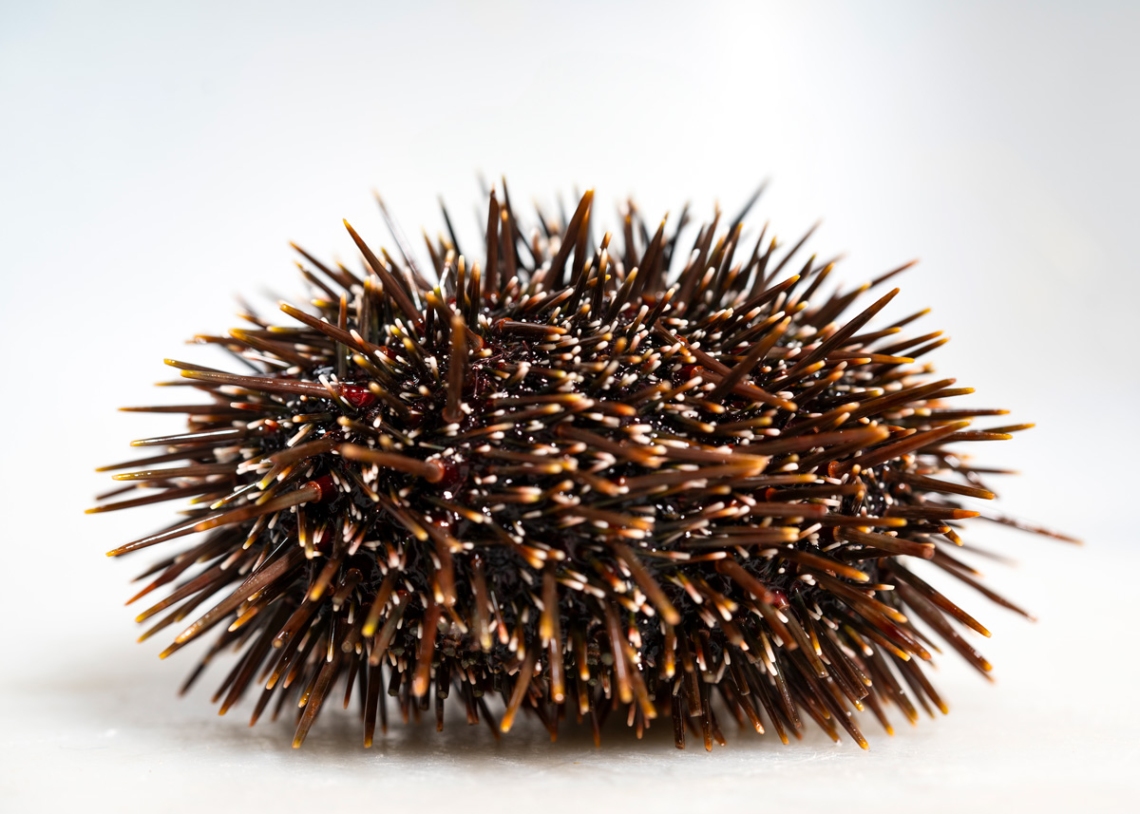On this page
What is a kina and where can you find it?
Kina (Evechinus chloroticus) is a type of sea urchin (also known as a sea egg), only found in Aotearoa-New Zealand.
Kina are the most common species of sea urchin found in shallow coastal waters surrounding Aotearoa and its offshore islands.
Like all the species in their group, their body is covered in sharp spikes and has the appearance of a curled-up hedgehog.
Kina usually inhabit rocky reefs in coastal environments, at shallow depths of around 10 meters.
They prefer kelp forests and encrusting coralline algae habitats, with moderate current and wave action.

 Did you know?
Did you know?
Kina are endemic, meaning they are only found in Aotearoa.
They are part of a worldwide fauna of approximately 500 species including starfish, feather stars, brittle stars and sea cucumbers.
Kina anatomy
Kina have a hard, round, protective exoskeleton called a teste made from calcium carbonate. The exterior is covered in numerous movable spines and tube feet that are used for defence, movement and respiration. Kina also use their tube feet to move food to their mouth.
Kina have a set of five self-sharpening teeth connected to a unique feeding apparatus called the Aristotle’s lantern that they use to chew and ingest food. Kina have very sharp teeth; sharp enough to eat through plastic.
Kina have a small trap door on the top of their shell, called a madreporite, that controls the flow of seawater in and out of their body like a hydraulic pump. They have minimal internal organs, as most of the internal teste space is used for gonad development.
The gonads are the reproductive organs producing either sperm or eggs. Male and female kina look the same until you open them. You may be able to tell the sex by looking at the gonads. Male gonads can often be paler in colour compared to female gonads and may have a milky substance, depending on local conditions.
Kina gonads can vary in shades from pale yellow to bright golden yellow. However, many environmental conditions affect kina gonad colour and quality, such as diet, season, habitat, and location.
 Did you know?
Did you know?
Kina hold significant culinary importance in Māori tradition. When they are ripe and in season their gonads swell. This is the best time to eat them.
Life cycle
The life cycle of kina begins with spawning, where eggs and sperm are released into the water in response to environmental cues.
Spawning
Adult kina spawn annually by releasing eggs and sperm into the water column simultaneously during the warmer months of spring and summer. The eggs are fertilised by the male sperm and develop into larvae.
Adults
Kina mature and begin to breed at about three or four years of age (>30 mm). Adult kina are thought to live up to 20 years and grow to 150-200 mm diameter depending on location and diet. Kina have the potential to reach a diameter of 190 mm (a small dinner plate), arguably making them the world’s largest sea urchin species.

Larvae
Fertilised eggs develop through multiple larval stages. The larvae float around the ocean feeding on plankton. Larvae settle after approximately 3-4 weeks on coral habitats, where they transform into juveniles.
Juveniles
Juveniles grow rapidly over the first 2-3 years. They are very cryptic, hiding under rocks until they are around 40 mm when they venture out into the open.
What do kina eat?
Kina serve as significant grazers in kelp forests.
They are mainly herbivorous, grazing on their favourite brown seaweeds and coralline algae. They have also been known to eat sponges and sea squirts if food is scarce.
They play a significant role in ecosystem balance by regulating the population of algae, preventing the overgrowth of underwater plant communities and ensuring stability and diversity of the marine ecosystem.

 Did you know?
Did you know?
Kina can regenerate spines if broken.
How do kina behave?
Kina are nocturnal, feeding mostly during dusk and dawn to avoid predators.
Kina do not move far and usually return to a home crevasse if predators such as blue cod, snapper, starfish and crayfish are present. They can also live in very dense groups.
Towards the end of its life, a kina undergoes a transformation where it sheds its spikes, revealing a captivating green globe-like shell. The empty shell shows an incredible arrangement of symmetrical dots where the spines were attached


What are the threats to kina and how can we help?
Kina face pressures from changes to their habitat and competition from other species:
- Pollution
- Habitat degradation, e.g., sedimentation effects on kina food sources
- Overfishing of key predators (e.g. snapper, blue cod and crayfish) leading to kina barrens
- Climate change effects such as:
- marine heat waves
- ocean warming and acidification
- extreme weather events such as storms
- Competition from the long-spined subtropical sea urchin, Centrostephanus rodgersii.
- Increased sea temperature has expanded the range of Centrostephanus to areas where historically only kina were found (currently Poor Knights to east coast). As it is quite different to kina and not endemic to Aotearoa but classed as a native that comes on the current from South Australia.
How can we help kina?
Restore habitats and maintain a balanced ecosystem
![]() Avoid overfishing key predators of kina to prevent overpopulation
Avoid overfishing key predators of kina to prevent overpopulation
![]() Protect and restore kina ecosystems and their habitat. Get involved in initiatives like riparian planting and coastal reforestation to help limit sediment input into the coastal environment.
Protect and restore kina ecosystems and their habitat. Get involved in initiatives like riparian planting and coastal reforestation to help limit sediment input into the coastal environment.
Kina fishery
The commercial fishery harvest is by free diving only within the quota allowance.
Recreational daily catch is 25-50 per person by scuba or free diving, depending on the region. There is no legal size to harvest kina; most roe is sold commercially on the New Zealand domestic market.
It is important to stay up to date on fishing regulations. Please check the regulations in your area regularly.
Kina contribute to the traditional Māori concept of “kaimoana”, which refers to seafood as a significant food resource. The harvesting of kina supports cultural practices and provides a valuable food source.
Note: Regulations as at September 2024
Outnumbered - kina barren
Fishing pressure on kina predators such as snapper, blue cod and crayfish may have contributed to the over-abundance of kina in some areas.
Swarms may strip a reef of its kelp, creating an open space known as a kina barren.
These barren areas can wreak havoc on entire coastlines. In the absence of kelp, there is no habitat for fish breeding or shelter for juvenile fish and crustaceans.
This results in a desolate landscape of barren rock.











